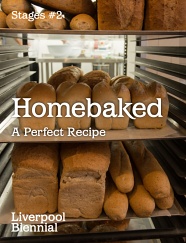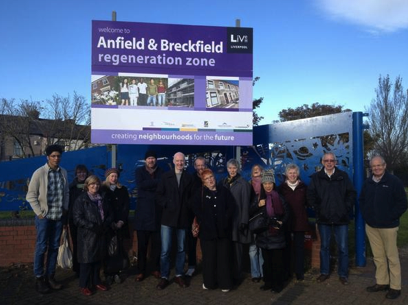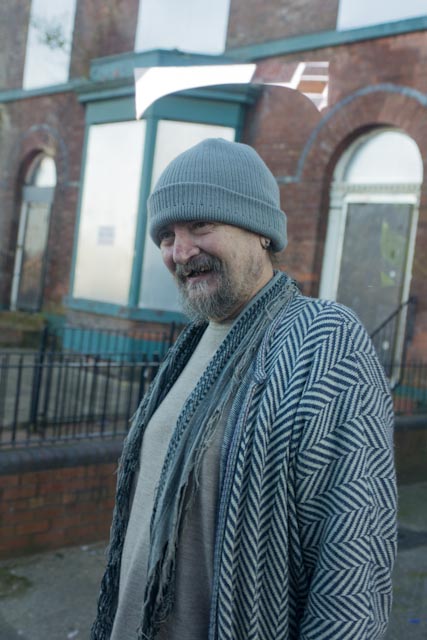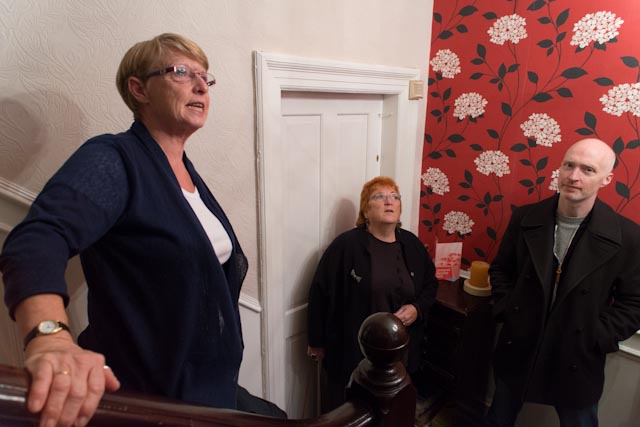
Performance, participation and questions of ownership in the Anfield Home Tour
Tim Jeeves
At the 2012 Liverpool Biennial, a significant number of encounters with
Homebaked / 2Up 2Down were facilitated through the performance The Anfield Home Tour,
It is not always easy to identify a recipe by taste alone; sometimes we can identify certain ingredients, but even if we manage this correctly, gaining an understanding of the method used to combine them is much harder. Nevertheless, in the following pages, I will reflect on my experiences both as an audience member of The Anfield Home Tour and as someone close to (though uninvolved in) the tour’s development,2 in an attempt to identify something of the recipe that the makers of this performance followed. I will look at what the intersection of audience, Anfield locals and professional artists provoked in this specific work, whilst also noting the risks and capabilities of such community-based performance work more generally.
At a fundamental level, performance is the meeting of bodies in space. It is an art form that creates encounters between people, and thus a space that facilitates experimentation with how we relate to each other. It develops new ways in which people, communities in the broadest sense, can be together. The narrative developed through such encounters has certain experiential qualities that are uniquely heightened through the performative moment. In Redefining Visceral Performance, Josephine Machon acknowledges these when she draws attention to the corporeal and emotional dimensions of performance. She expounds a theory of ‘(syn)aesthetics’, the experience of ‘fusing of sense (semantic “meaning making”) with sense (feeling, both sensation and emotion) [that] establishes a double-edged rendering of making-sense/sense making’.3 Although she does not deny the place of intellect in developing meaning, Machon’s position is that the (syn)aesthetic encounter also essentially encompasses both sensory and affective stimuli.
In the case of The Anfield Home Tour, the audience, by being guided through the streets of Anfield, being invited into people’s houses and, at one point, being asked to pass amongst themselves a brick similar to those used in the construction of these houses, encounter, in an embodied and multi-sensorial manner, the story of the area. They gain a perspective that is very different from that achieved by reading the same stories on a page. This is noted, not to generate a hierarchy of narrative media, but as an observation of how different forms of narrative demand diverse modes of engagement. When encountering a written narrative, a reader has more control over their engagement: they can scan backwards and skip forwards through the text at will, choose to linger on a particular detail, and cross-reference back across the temporality prescribed by the pages with relative ease. Performance, meanwhile, will, in most instances, progress at its own pace. Although this does not render performance audiences passive (from Barthes, through Ranciere and beyond, much attention has been given to the active engagement that texts, including performance texts, demand of their readers) it is nevertheless the case that, whilst their own affective histories, political tendencies and personal relations all shape the narrative that audiences experience and how they react to it, they are also encouraged – by their status as audience – to accept a certain lack of autonomy in relation to this narrative. Different activity is asked of the person hearing a story and the person telling it.
Although audience members were undeniably inside the content of The Anfield Home Tour (after all, they were surrounded by the fabric of what was being described), even those who knew the narrative first hand were, in the context of the performance, also placed to a marked degree outside the narrative as it was presented. At one point, relatively early in the tour, the bus stopped near a sign promoting the ‘Anfield and Breckfield regeneration zone’. After Carl had delivered some banter about how long the sign had been there, visitors were invited to stand beneath it. On the count of three, they shouted out ‘Regeneration’ and had their photo taken. As Gareth White notes in his article ‘On Immersive Theatre’,4 the metaphors we apply to art often spatially identify them as containers from which we extract meaning – we ‘get something out of them’ and ‘immerse ourselves within them’. The act of taking a photo in this way, however, places audience members outside in another sense. They adopt the role of the tourist, a visitor who is trying to gain understanding of the area.

Photo: Carl Ainsworth
This position of the visitors changes as the narrative of the tour progresses: there is a gradual invitation into the inside. They move from being tourists, to being a guest in someone’s house, until finally they arrive at the bakery itself. Here, the structured performance is over, the dichotomy between performers and audience breaks down, and as they chat with the staff and members of Homebaked, they are invited to register either as supporters (for e-mail updates), or as members (if they live close enough to come to meetings). In this way, they are given the chance either to extend the narrative, or contribute more integrally to its creation.
Of course, the audience is only one part of the equation in a performative encounter. When those inside the performance are from the local community, as was the case with The Anfield Home Tour, it is also worth exploring how such participation affects the narrative presented. As Jen Harvie notes in her analysis of Roger Hiorn’s installation Seizure,5 there is a risk, when participation in artworks is unpaid, that neoliberal agendas around volunteerism are reinforced. In works where performance is delegated to non-professionals, it is important to trace the gains made from the performance. Harvie makes parallels between this work and the coalition government’s ideas of the Big Society, in which volunteering is used as a means to cut costs and ensure that an ideological focus on individual responsibility for wellbeing remains intact: ‘while it [the Big Society] may indeed call for volunteering and other acts of private giving, it does not necessarily propose to match that giving with public – or state – support for those in need.’6
In her development of a similar critique, Claire Bishop notes that whilst exploitation is a possibility in such work, it should not override all other considerations. There are instances in which a challenge to cultural norms is made precisely through their re-enactment; we should not write off ‘work that reifies precisely in order to discuss reification, or that exploits precisely to thematize exploitation itself’.7 Whilst those members of the community who were present as performers on The Anfield Home Tour route were reimbursed financially for this role, the nature of the project inevitably meant that others made unpaid contributions. Even though these projects were not concerned with exploring labour relations in the manner identified by Bishop, the argument that these unpaid contributions were therefore exploitative feels somewhat shallow and simplistically conceived.
Whilst the ownership of the work (and therefore a significant proportion of the gains made within this field) remains with the Biennial, van Heeswijk and the creative team that developed the tour, the fact that the impact of these works reverberates far beyond this field is significant (not least, because the gains in cultural capital made by these parties are inextricably linked to this reverberation; the project is significant in the art world because of its significance in broader society). By being so firmly rooted in the area in which it is presented, the ownership addressed by Homebaked and The Anfield Home Tour becomes less about their authorship as projects, and more about the ownership of the area in which they take place. And this latter, more expansive sense of ownership is very much the concern of the local community. The Biennial, van Heeswijk and the creative team behind the tour neither have, nor make, any claim on this (other than as stakeholders in the bakery or as local residents, like tens, if not hundreds, of other people).
Aside from the legal determination of possession, questions of responsibility and entitlement are decisive factors in claims to ownership, and it is ownership of the area in this sense that is renegotiated through the performance of the Anfield Home Tour. In Anfield, the legal identity of the area is clearly defined: compulsory purchase orders have seen large parts taken into ownership of the council. Nevertheless, outside of the law, questions about who is entitled to make decisions for the area and who is responsible for what happens on those streets remain. The Anfield Home Tour gave voice to the people with, arguably, the most entitlement to the area: those whose identities are meshed with the bricks and mortar of the houses bought through the Housing Market Renewal Initiative (HMRI). The significance of this act of voicing narrative, (syn)aesthetically or otherwise, can be used to intervene in assertions of ownership; change the story that is told, and claims to ownership are also altered.
These new claims of ownership are inevitably open to contestation, but the encounters between the audience and people whose identity is, in a very real sense, determined by the streets where the encounters take place, very directly establishes a link between these people and the streets, lending an authenticity to the claims of ownership and truth implicit within the narrative. Not all the narrative encounters in The Anfield Home Tour were presented with the local voice, however. The tour guide was played by actor Graham Hicks, and, although he has a talent for comedic improvisation, he followed a collaboratively devised script for much of the tour. The ordering of the script had a significant influence on narrative construction, both in determining what was told and the positions taken by the audience in relation to that information. Scripting allowed particular information to be delivered at an appropriate time.
Before going into the heart of the Housing Market Renewal area, Hicks, as Carl, provided some historical contextualisation of the area. Stopping off in Everton Park he talked of the processes of regeneration that had dominated the area for the last fifty years. The characters he talked about – his Nan and his Auntie Carol – were fabricated; they were fiction. Nevertheless, they served an essential role in contextualising the narrative of the tour, the narrative of Homebaked, the narrative of the area. These characters didn’t exist. But they could have. The story they told is the story of the area. They acted as a filter for the voices of hundreds of lives.
Hicks adopts the voice of a local to tell the story, even though he has never lived there (although it is worth noting that he isn’t exactly an outsider; he grew up in Liverpool and knew the area before the project). Such an approach is risky: even with the best of intentions, such influence can impact on the story told. Changes in the ownership of narrative readily distort the narrative of ownership. Nevertheless, these concerns were substantially ameliorated in the context of the tour, where there was firm links between the director of the piece and the locality (Britt Jurgensen is both an Anfield resident and had been working with Homebaked for over a year before The Anfield Home Tour). Even more significantly though, a range of people from the area were taken on work-in-progress showings and given the right to veto any elements they did not feel were appropriate.
Carl adopts the voice of the local because that was the through-line of the performance; his character set the audience up for the encounters they would have with people from the area later in the tour:

Photo: Mark Loudon
Fred Brown remains living in his house whilst those on the other side of the street have been demolished. Fred told the story of a day when a shiny digger first turned up, before a group of people in suits arrived in fancy cars. Then the photographers arrived.
After the photos were taken, everyone left and it was weeks before the demolition proper began.

Photo: Mark Loudon
The house that Jayne Lawless grew up in was sold by her parents when the community around them started to be dismantled. Returning to the tinned up house years after they had been forced to leave, she told audiences how she could hear the smoke alarm, still beeping inside, ‘still trying to protect us, even though we're not there anymore’.

Photo: Mark Loudon
Sue Humphreys, whose house has been in her family for three generations, invited the audience into her home and gave them a personal history of her family, of the house, and of the area.
These voices, the stories they tell, the performance of Anfield’s everyday life that they provide, enacts a profound challenge to the more dominant narrative: that the houses are deprived and in disrepair, that regeneration is an uncomplicated improvement, that people simply don’t know what’s good for them.
Lawless describes it eloquently:
From what I understand, and how I figure it, this was all about money. There was a big pot of gold. In order to access that pot, this area had to tick so many boxes in the magical world of deprivation. So suddenly, we were being told all the time that we were from this ‘deprived area’.
And we were like, ‘I'm not deprived. I don't feel deprived. We have food; we have clothes, both parents work. How am I deprived?’ But the more you feed that in: ‘You're poor, you're this you're that’, you watch the standards drop; everything seemed to drop and it took about ten years, but they finally ticked that last box they needed to tick, and that was that, really.
The challenge to the dominant narrative has nuance though. It would be too simple just to oppose the new developments, to ignore the benefits that may accompany them, to focus solely on the undeniable injustice, and by doing so risk encouraging hostility towards the people who have moved into the newly built houses. As happens elsewhere in the performance, fiction and non-fiction combine to (syn)aesthetically present this nuance. Those on the bus are told about Carl’s fictional friend, Donkey, drinking beer and sunning himself in his new garden, phoning Carl to gloat about it, whilst soon afterwards they meet Bob, someone who used to live in the area but has now happily moved into one of the new builds after his previous house developed a mould problem (thanks to the empty houses on either side).
The tour overlaid the local voice onto the dominant narrative. It was a palimpsest that suggested that, although the problems in the past might have been to do with compulsory purchase and forced regeneration, the significant issue for the area now is that the proposed redevelopment has ground to a halt, the construction of new homes stagnating amidst the closure of the HMRI fund and the uncertainty (since resolved) of whether Liverpool FC was going to expand their stadium or move it elsewhere. By presenting the nuance of the situation, and then bringing the audience to meet the people involved with the bakery over tea and cakes at the tour’s conclusion, the team gave the audience the space to make up their own minds about what, if anything, they wanted to contribute.
And it is here that the value of performative encounters such as The Anfield Home Tour lies. They create a trajectory of action for the audience, first showing a narrative, then bringing them inside, and then, when the performance concludes, providing a space through which that trajectory can continue. If there is a recipe for The Anfield Home Tour, it is a recipe for an appetizer. Although the performance might be tasty, its real value lies in its ability to whet the appetite for further action.
Archive
The Anfield Home Tour, Deborah Morgan, 2012.
1 The Anfield Home Tour
Original idea: Jeanne van Heeswijk
Written and co-devised by: Britt Jurgensen (director), Deborah Morgan (writer) and Graham Hicks (performer).
With original text by Fred Brown, Jayne Lawless, Bob Norman and Susan Humphreys.
With input and inspiration from Lynn Tolmon, Laurie Peake, Angela McKay, Samantha Jones, Roselyn Groves, Bob Blanchard, Andrea Jones, Patrick and Carol McKay, Maria Brewster and Franny George
2 I have personal relationships with a number of the creative team that produced the tour.
3 Josephine Machon, (Syn)aesthetics: Redefining Visceral Performance, Palgrave, London, 2009, p.14.
4 Gareth White, ‘On Immersive Theatre’, Theatre Research International (37), 2012, pp.221–235.
5 In 2008, Hiorn lined the inside of an empty flat in Peckham, South London with copper sulphate crystals. In 2013, the entire flat was taken up the M1 motorway and installed in Yorkshire Sculpture Park.
6 Jen Harvie, ‘Democracy and Neoliberalism in Art's Social Turn and Roger Hiorns's Seizure’, Performance Research: A Journal of the Performing Arts, 16:2, 2011, p.120.
7 Claire Bishop, ‘Delegated Performance, Outsourcing Authenticity’, October, 140, 2012, p.111.
Download this article as PDF
Tim Jeeves
Tim Jeeves is a performance-maker and writer who, in recent years, has concentrated on making work in his adopted home of Liverpool. Since 2011, with the support of Arts Council England and The Bluecoat, he has produced the Giving in to Gift festival, whilst in 2013, he worked with the learning disability company RAWDto create How to Fall in Love, a performative ‘date’ for two audience members at a time, that was one of Seven Streets Almanac’s top 7 theatre shows of 2013. He is currently completing a PhD at Lancaster University, and together with long-term collaborator Cecilia Wee has been awarded an AN bursary to develop The Artist plc, a crypto-currency for trade in cultural value.
- Introduction
Jeanne van Heeswijk and Britt Jurgensen - Becoming Homebaked
Samantha Jones - Millionaire's Shortbread
Recipes by the Homebaked Chefs - Taking Space
Don Mitchell - Envisioning Public Cooperative Housing
Gabriela Rendon - Carrot Cake
Recipes by the Homebaked Chefs - Performance, participation and questions of ownership in the Anfield Home Tour
Tim Jeeves - 2Up 2Down/Homebaked and the Symbolic Media Narrative
Sue Bell Yank - Walton Breck White
Recipes by the Homebaked Chefs - Shankley Pie
Recipes by the Homebaked Chefs - A Creative Alternative?
Kenn Taylor - Homebaked Portraits
Mark Loudon - Colophon